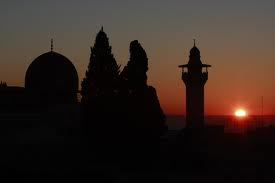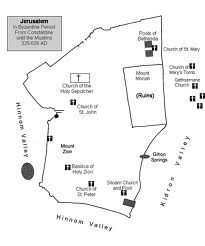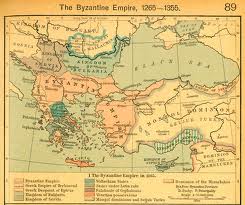|
Jerusalem has a long history of re-conquest. It has been ruled by the Jews, Babylonians, Egyptians, Greeks, Romans, the Byzantine Empire, Suljuk Turks, Marmulkes, European Crusaders, Ottoman Empire, Britain, and (returning full circle) Israel. Hadrian renamed the land of Israel after the Jews ancient enemy the Philistines. He called it “Palestine.” He renamed Jerusalem after himself and called it “Aelia Capitalina.”
Jerusalem's official status within the church hierarchy was also enhanced. Coinciding with the appointment of the city's bishop, Juvenal, as Patriarch, Jerusalem was made a patriarchate, joining Rome, Constantinople, Antioch and Alexandria.

The planning of Byzantine Jerusalem was based upon the standard Roman city. This is evidenced by the way the city was rebuilt upon the ruins of Jewish Jerusalem, which the Romans renamed "Aelia Capitolina". From this period we find remnants of many Byzantine and Roman structures.
In 73, Masada, the outpost that had provided weapons to Jerusalem during the Great Revolt, was ultimately conquered only to find that hundreds of defenders had chosen suicide over slavery. (Encyclopedia of the Bible, volume 4, pg. 112). In 132 AD the next major Jerusalem catastrophe began. Jerusalem became a Roman colony, and an altar of Jupiter being put up in the desecrated the temple area.

The foundation of Constantine's project to reconsecrate Jerusalem to Christ was laid in 325 AD at the council of Nicea (modern Iznik, Turkey). It was here that he summoned the bishops of the Christian world to reconcile a number of pressing doctrinal questions that threatened to tear the church apart. One of the bishops, Macarius of Jerusalem, sought out the Empress Helena, Constantine's mother, whose influence at her son's court had grown with her advanced age.
Macarius told Helena of the neglect that had shrouded the sites of Jesus' birth, crucifixion and resurrection for some 300 years. Persuaded by the bishop's passion, the eighty-year-old Queen Mother set out for Jerusalem with Macarius as her guide, and supplied with sufficient funds to start the necessary work. Helena's discoveries confirmed Jerusalem as the holiest city of the Christian world; Jerusalem now became a focus for pilgrimage for millions of Christians who came contemplate the important events in the lives of Jesus, the Apostles and the early martyrs of the faith.

For contemporary Christians Jerusalem was above all else the actual site of the great events of the Scriptures, the church of Jerusalem celebrated each holiday at its historic location. Byzantine Jerusalem was intended to absorb thousands of pilgrims, and from inception was built with the intention of providing for their accommodation. However, the earliest available documentation regarding the structure of the city is from a period about 200 years later, and is known as the Medeba Map. The holy places became the stage on which the Biblical tales were presented as plays, with the participation of worshippers and pilgrims.
When Titus attacked Jerusalem in 70 AD, he burned the city, burned down the Temple, slaughtered over one million Jews, and sold the survivors as slaves to foreign merchants who carried them off to the various nations of the world.
In 614 the country fell to the Persians. The conquest of Jerusalem was a bloody affair in which thousands of inhabitants were massacred. Many churches, including the Church of the Holy Sepulchre, were destroyed and others were damaged. The sacred cross upon which Jesus was crucified was looted.
The discovery of a few relics in Jerusalem at a time when Christianity had just become the official religion of the Eastern Empire had important repercussions for the city's development. Jerusalem was transformed from a relatively insignificant, provincial city in the Roman Empire to the focus of pilgrimage and adoration by another major religion in addition to Judaism. This would be the beginning of inter-religious rivalry in the city, which would be joined three centuries later by the advent of Islam.
|

![]()


